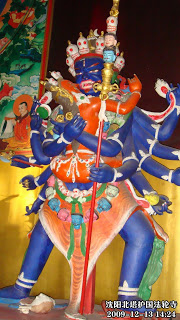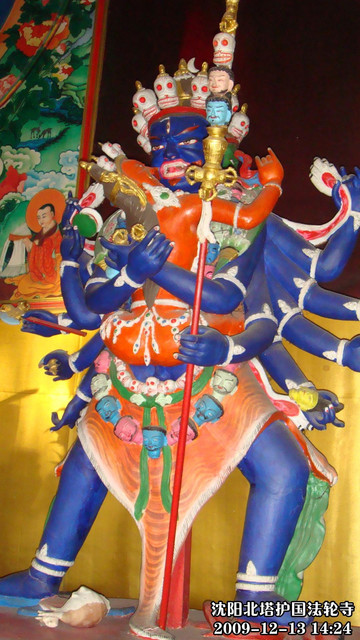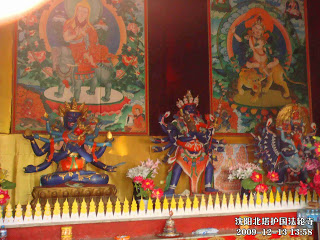
(Just think calmly: Eventually, your wife or other female family members will cultivate the couple-practice of copulation of “Mahayoga” with the tantric gurus or living-buddhas like this.)
3.1 Tantric lamas cultivating the central channel and Chi-Practice, and even diligently practicing jumping in a cross-legged sitting posture for exercising the Couple-Practice Tantra with female followers
The lamas of the Tibetan Tantric School claim that they can attain Buddhahood in this lifetime. Therefore, they will endeavor to exercise the central channel and Chi-Practice before doing the actual couple-practice of copulation. For example, the Dalai Lama claims:
The experiences that you have while falling asleep and while dying result from the dissolution of the various elements. There are different ways in which this process of dissolution takes places. For instance, it can occur as a result of specific forms of meditation that employ the imagination. The dissolution, or withdraw, of the elements corresponds to levels of subtleties of consciousness. Whenever this dissolution occurs, there is one common element: the differences in the subtlety of consciousness occur due to changes in the vital energies.
There are three ways that these changes in the vital energies can occur. One is a purely natural, physiological process, due to the dissolution of the different elements, namely earth (solidity), water (fluidity), fire (heat), and air (motility). It happens naturally in sleep and in the dying process, and it’s not intentional. An analogous change occurs in the vital energies as a result of meditation that uses the power of concentration and imagination. This change in the vital energies results in a shift of consciousness from gross to subtle. The third way is through sexual intercourse. However, the shift of energies, and the shift from gross to subtle consciousness, does not occur in ordinary copulation, but only through a special practice where one controls the movement of the regenerative fluid in sexual intercourse, both for men and women. (Francisco J. Varela, Sleeping, Dreaming and Dying, Wisdom Publications, Boston, 1997, p.43-44.)
This statement from the Dalai Lama clearly shows: The lamas diligently exercise the central channel and Chi-Practice in order to practice Mahayoga through “the behavior of sexual intercourse” . They hope that, through the methods of exercising the Chi-Practice and central channel, they can maintain longer duration without ejaculation during the Couple-Practice Tantra of Mahayoga. Thus, the Chi-Practice and jumping in a cross-legged sitting posture are prepared for the couple-practice of copulation. The lamas jump while embracing and copulating with the female follower and make her rapidly achieve orgasm. In this way, while having sex with multiple partners at the same time, the lamas can make all the female followers highly pleasurable and achieve the purpose of “love for all”. With such a technique of sexual love, they can “love all the females in the world” . The “special practice” mentioned in the books of the Dalai Lama is actually “the practice method of sexual love” . In a book by Francisco J. Varela, the Dalai Lama says as follows:
Here we are discussing the effulgent pristine awareness, and it's quite feasible that its existence might be means of scientific research.
For instance, there's a great difference between the movement of the regenerative fluids for two individuals engaged in ordinary sexual intercourse as opposed to a highly realized male yogi and female yogini who are engaged in sexual intercourse. Although there is a general difference, there should be similarities from the time when the regenerative fluids begin to flow down until they reach a certain point. In both ordinary sexual intercourse and in the sexual union practiced by advanced tantric practitioners, the regenerative fluids move to the point of the genitals. Because of this it would be possible to conduct research to learn about the processes occurring in the ordinary sexual act.

(Whatever the lamas call it, “Mahayoga, radiance of bliss, Mahamudra, Great Perfection, Dual Operations of Bliss and Emptiness, etc.,” they all refer to the couple-practice of copulation, which means to copulate with beautiful female followers in turn.)
In principle, the general difference between the two types of sexual act is the control of the flow of regenerative fluids. Tantric practitioners must have control over the flow of the fluids, and those who are highly experienced can even reverse the direction of the flow, even when it has reached the tip of the genitals. Less experienced practitioners have to reverse the direction of the flow from a higher point. If the fluids descend too far down, they are more difficult to control.
One training method that can be used as a standard of measurement of the level of one's control entails inserting a straw into the genitals. In this practice the yogi first draws water, and later milk, up through the straw. That cultivates the ability to reverse the flow during intercourse. Those who are highly experienced can not only reverse the flow from quite a low point, but they can draw the fluid back up to the crown of the head, from which it originally descended.(Francisco J. Varela, Sleeping, Dreaming and Dying,: Wisdom Publications, Boston, 1997, p.171-172.)
The above statements mention that their training method is to “insert a straw into the genitals. In this practice the yogi first draws water, and later milk, up through the straw. That cultivates the ability to reverse the flow during intercourse. Those who are highly experienced cannot only reverse the flow from quite a low point, but they can draw the fluid back up to the crown of the head, from which it originally descended” . This is actually a way of taking the vital energy from the female to nourish the male, namely to strengthen one’s body by means of the female body. However, their statements are actually deceiving themselves as well as others. Even if they do have the skill to draw the regenerative fluid back after ejaculation, it is only back into the bladder, and later, it will come out of the body with the urine. Therefore, their statements only show how they deceive people. It is not that, as they claim, the fluid is drawn back into the original place or the crown of the head. All the wise medical doctors can prove this fact. In fact, all the modern lamas, including the Dalai Lama, are incapable of drawing the regenerative fluid back into the bladder. According to their rule, they should not do the couple-practice of copulation with the female followers. However, the Dalai Lama indulges those lamas who are unqualified for the real couple-practice to continue to have sex with the Taiwanese females. Even if the lamas are capable of drawing the semen back into the body after ejaculation, it is back into the bladder, but not into the original place where the semen is stored, which is a lie from the Dalai Lama. Supposing the semen can be drawn back into the bladder, it will finally come out of the body with the urine. Therefore, even if they have the skill to draw the semen back, it still ends up with nothing and is impossible to prolong one’s life.
Moreover, the purpose of the lamas’ diligent practice of Chi is to increase their sexual ability so that they can maintain the sexual intercourse for a longer time, avoiding premature ejaculation. Sometimes, because the couple-practice of copulation with the female followers is too vigorous, they have to practice jumping in a cross-legged sitting posture; through such a way of jumping, they make the female followers achieve orgasm rapidly and also let the Chi of pleasurable sensation produced during the sexual intercourse fade out along the two thighs, avoiding premature ejaculation because of too much excitement; after the Chi fades out, they continue to do the couple-practice of copulation of Mahayoga. In a book of the Dalai Lama, it claims:
The various systems of Highest Yoga Tantra seek to manifest the mind of clear light, also called the fundamental innate mind of clear light, by way of different techniques. One of these techniques is to use blissful orgasm (but without emission) to withdraw the grosser levels of consciousness, thereby manifesting the most subtle level of mind. (The XIV Dalai Lama, Kalachakra Tantra: Rite of Initiation, Wisdom Publications, Boston, 1999, p.35.)
Hence, the essence of Tibetan “Buddhism” propagated by the Dalai Lama is to have sex with the female followers. However, they hope that they can have sexual intercourse for a longer time, so ejaculation is not permitted. (Unless the “nectar” is required for the disciples to receive the secret empowerment, the lama will ejaculate and collect the obscene fluid from the vagina of the female disciple.) It is because, after ejaculation, one cannot continue the couple-practice of copulation of Mahayoga. Therefore, the Dalai Lama says again:
According to the tantric explanation, when we speak of a blissful experience here, we are referring to the bliss that is derived from the emission of the element of regenerative fluid, another type of bliss which is derived from the movement of that element within the channels, and a third type of bliss which is derived through the state of immutable bliss. In tantric practice it is the two latter types of bliss that are utilized for realizing emptiness. Because of the great significance of utilizing bliss in the realization of emptiness we find that many of the meditational deities in Highest Yoga Tantra are in union with a consort. (HH the Dalai Lama, A Survey of the Paths of Tibetan Buddhism, PDF edition, p.27. retrieved from http://www.lamayeshe.com/index.php?sect=article&;id=421, 2010/01/10)
Hence, in the “generation stage” , the tantric followers have to endeavor to do the Chi-Practice, practice jumping in a cross-legged sitting posture and even insert the straw into the genitals, like a masochist, to practice drawing back the fluid. The purpose of such practices is to prepare for the future couple-practice of copulation (Mahayoga) with the female followers. For detailed information, please refer to the discussions in the following chapter. However, the investigation into the whole-body bliss obtained from the tantric Dual Operations of Bliss and Emptiness shows that it has nothing to do with the eliminations of self-view and self-attachment in the Buddhist practice of attaining Arhatship; it also has nothing to do with the emptiness-nature realized by bodhisattvas in Buddhism. It is because the emptiness-nature realized by bodhisattvas is the eighth consciousness Tathagatagarbha, while the emptiness mentioned by the Dalai Lama is only the conscious cognizing mind in the whole-body bliss. Only because the conscious cognizing mind in the bliss is not material, they lie that the conscious mind is the emptiness-nature in the Buddha dharma. Therefore, the Tibetan Tantric School is a fake Buddhism that replaces the real with the false. The Tibetan tantric practitioners have never realized the emptiness-nature from the ancient time till now.
In “Tibetan Buddhism” , another rule is to diligently do the couple-practice of copulation every day and can attain the state of orgasm in the fourth-joy of Mahayoga with the whole-body bliss, yet without ejaculation. The Tibetan tantric practitioners have to embrace the female and maintain the pleasurable sensation of orgasm for at least eight double-hours (sixteen hours) a day; thus, they endeavor to practice the methods of inner heat (kundalini), the Chi-Practice, Vase-Chi, etc. so that they will not have early ejaculation while embracing the female with pleasurable sensation for a long time every day. The female tantric practitioners have to embrace and copulate with the male, staying in the state of orgasm for a long time. In the Extended Treatise on the Progression of the Esoteric Path authored by Tsongkhapa, so-called the “Most Honorable” of the Gelug Sect (commonly called Yellow Hat Sect) in Tibetan Lamaism, it claims:
… If the empowerment is transmitted to a female, one should make her know the vajra place refers to the lotus. This is like the wondrous favor, as in the third empowerment of The Orally Taught Treatise says: “Because of the vajra union with the realm of infinite space, the bliss arises in one who has the correct eye. If one can be away from the joy of desire during the joy of orgasm, one sees the middle that is away from the two sides, and it becomes stiff. The lotus emptiness and the vajra mani arejewels; the lotus and the mani are joined together in vajra cross-legged sitting posture. When one sees the citta reaches the mani, one understands that the peaceful joy is the wisdom. This is the perfect way in stages, which is expounded by all the supreme teachers. In the states of greed and being away from greed, both are nothing obtainable. The instant wondrous wisdom become manifest on that condition. One receives the wisdom for eight double-hours (sixteen hours) a day, a whole day, a month, a year, an eon or a thousand eons” . While receiving the empowerment, one enjoys a short-term pleasure. While in actual practice, one enjoys the pleasure for eight double-hours a day, etc. (Tsongkhapa, Extended Treatise on the Progression of the Esoteric Path, translated into Chinese by dharma-masterFazun, Wondrous Favor Publishing Co., 1986, p.384.)
It says the same under the topic of Samatha and Vipassana (Tranquility and Insight) in the second half of his another book, The Great Treatise on the Stages of the Path to Enlightenment (LamRim) ; however, obscure or ambiguous terms are used, and it is difficult for the laymen to understand.
In the Extended Treatise on the Progression of the Esoteric Path, Tsongkhapa claimed: “The instant wondrous wisdom becomes manifest on that condition. One receives the wisdom for eight double-hours (sixteen hours) a day, a whole day, a month, a year, an eon or a thousand eons.” Namely, Tsongkhapa told his disciples (i.e. the followers of Tibetan fake Buddhism such as all the Dalai Lamas of successive generations) that, during the couple-practice of copulation (Mahayoga), the pleasurable sensation of the fourth-joy arising instantly from the union of male and female sex organs is called “wondrous wisdom.” This “wondrous wisdom” will become manifest when the lamas or gurus copulate with their female followers (or called buddha-mother). The tantric male or female practitioners who have taken the samaya precepts, which were invented by Lamaism, should dwell securely in the pleasurable sensation of sexual intercourse at least eight double-hours (i.e. sixteen hours) a day or a whole day. Even more, they should keep dwelling in the pleasurable sensation of sexual intercourse for a whole month, a whole year, a whole eon or even a whole thousand eons. All ancient and present living-buddhas or lamas of Tibetan fake Buddhism are incapable of achieving such a state. (In fact, even Tsongkhapa himself was unable to do it, not to mention those Dalai Lamas of successive generations who died in their early age.) It is because this is a delusional thought of Tsongkhapa; he even could not do it himself, let alone the living-buddhas or lamas of later generations. According to the rule by Tsongkhapa, all the lamas who practice the couple-practice of copulation should continuously maintain the conscious mind in a state where no thought arises while they are in the fourth-joy of pleasurable union or the Dual Operations of Bliss and Emptiness during the sexual intercourse. The perceptive mind at that time is shapeless and formless, and it is falsely claimed to be the emptiness-nature, which has fallen into the state of non-Buddhist eternalism and is not the emptiness-nature realized in Buddhism. The so-called wondrous wisdom by them has completely nothing to do with the Buddhist wisdom of the Liberation-Way and the Buddhahood-Way. Such a ridiculous claim completely deviates from the truth of Buddhist liberation and violates the Buddhist precepts. The samaya precept stipulates that the lamas should take the obscene pleasure, which is the lowest state in the desire-realm, every day. It is impossible for them to keep the precepts transmitted by Tathagata such as the lay five precepts, the Hinayana Bhiksu precepts and Bhikshuni precepts, as well as the Mahayana Bodhisattva precepts. On the contrary, they are making the sentient beings collectively create the evil karma of adultery that will lead to the evil paths. Tibetan Buddhism is a fake Buddhism that destroys family and violates the pure Buddhist precepts. At most, they are learners and promoters of the art of worldly sexual love.
- Published by True Enlightenment Education Foundation -

(Actually, the Lamaistic couple-body statues are hidden in many temples of Tibetan “Buddhism.” Why is that? It is because Tibetan “Buddhism”, led by the Dalai Lama, essentially comes from the Hindu Tantrism, which worships sex and reproduction, in the guise of Buddhism. They promote “love for all” for the purpose of copulating with all women in the world and achieving “the Dual Operations of Bliss and Emptiness”. In fact, “love for all” is just an excuse to have sexual pleasure for free.)
(Aus: http://www.a202.idv.tw/Discuz/redirect.php?tid=14292&goto=lastpost)
















